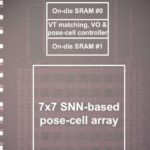Paper, Technology Based on Rodent Neurons
Simultaneous localization and mapping (SLAM) is a quintessential problem in autonomous navigation, augmented reality, and virtual reality. In particular, low-power SLAM has gained increasing importance for its applications in power-limited edge devices such as unmanned aerial vehicles (UAVs) and small-sized cars that constitute devices with edge intelligence. This article presents a 7.25-to-8.79-TOPS/W mixed-signal oscillator-based SLAM accelerator for applications in edge robotics. This study proposes a neuromorphic SLAM IC, called NeuroSLAM, employing oscillator-based pose-cells and a digital head direction cell to mimic place cells and head direction cells that have been discovered in a rodent brain. The oscillatory network emulates a spiking neural network and its continuous attractor property achieves spatial cognition with a sparse energy distribution, similar to the brains of rodents. Furthermore, a lightweight vision system with a max-pooling is implemented to support low-power visual odometry and re-localization. The test chip fabricated in a 65-nm CMOS exhibits a peak energy efficiency of 8.79 TOPS/W with a power consumption of 23.82 mW.
Learn about our two Decals!
 Click here to find out more about our Fall Bioinspired Design Decal and our Spring Bioinspired Design in Action Decal – ALL MAJORS are welcome.
Click here to find out more about our Fall Bioinspired Design Decal and our Spring Bioinspired Design in Action Decal – ALL MAJORS are welcome.Berkeley BioDesign Community
 Click here to learn about the BioD: Bio-Inspired Design @ Berkeley student organization or here to signup for more info.
Click here to learn about the BioD: Bio-Inspired Design @ Berkeley student organization or here to signup for more info.Search
Student Login




I imagine that the neurological circuits underlying these processes are governed by both 2d spacing maps with their brains as…
to reduce the impact of car accidents, it may be possible to study the force diverting physics of cockroaches to…
you see this type of head-bobbing stability in many avian creatures related to pigeons like chickens. the head ability to…
not like they taught horses how to run! this is an example of convergent evolution where both sea creatures and…
The brain functions in a similar way with neuronal connections. our brains are able to utilize the multiplicity of connections…